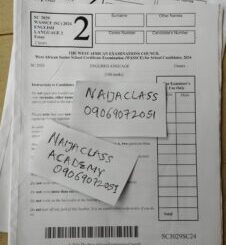Welcome to “Naijaclass Academy” For Waec May/June 2024 Financial Accounting Answer
Date: Tuesday, 21st May, 2024
Financial Accounting (Essay & Objective) 9:30 am – 1:00 pm.
Accounting OBJ
1-10: CDBACACBBC
11-20: CDDBDBDACB
21-30: AADCCBBBBB
31-40: ACBBDDADAA
41-50: CCDABDBBCD
===========================
FINANCIAL ACCOUNTING
(3a) Ose operate with Single Entry System of bookeeping. This system is typically used by small businesses or sole proprietors who do not keep proper books of account. In the single entry system, only one side of each transaction (either debit or credit) is recorded, which contrasts with the double entry system where every transaction affects at least two accounts.
(3b)
ADVANTAGES:
(PICK ANY THREE)
(i)The single entry system is easy to understand and use, making it accessible to those without formal accounting knowledge. It involves fewer records and less complex procedures.
(ii)Implementing and maintaining a single entry system is inexpensive. It does not require advanced accounting software or professional accountants, which can be costly for small businesses.
(iii)This system takes less time to manage compared to the double entry system. Business owners can spend more time focusing on their core operations rather than on detailed bookkeeping.
(iv)The single entry system requires minimal paperwork and fewer records. This reduces the administrative burden on the business owner.
(v)The system offers flexibility as it does not follow strict accounting rules and procedures. This can be advantageous for small businesses with straightforward transactions.
DISADVANTAGES:
(PICK ANY THREE)
(i)The single entry system can lead to incomplete and inaccurate financial records. Since it does not track both sides of transactions, there is a higher risk of errors and omissions
(ii)Due to the lack of checks and balances inherent in the double entry system, the single entry system is more susceptible to fraud and errors. It is difficult to detect discrepancies and irregularities.
(iii)The limited financial information provided by the single entry system makes it difficult for business owners to make informed decisions. Critical financial metrics and insights are often missing.
(iv)Financial institutions typically require detailed and accurate financial records when assessing loan applications. The single entry system’s lack of comprehensive financial data can make it difficult for businesses to obtain financing or attract investors.
=========================
========================================
(1a)
(i) Purchase of office equipment on credit: General Journal
(ii) Credit purchases: Purchases Day Book
(iii) Bank charges: Cash Book
(iv) Goods returned by a customer: Returns Inwards Book
(1b)
(i) Purchases Journal: The total of all credit purchases is transferred from the purchases journal.
(ii) Cash payments: Details of payments made to suppliers are recorded in the cash book.
(iii) Returns outwards: This journal records goods returned to suppliers.
(iv) Discount received: Discounts received from suppliers are recorded in the cash book along with payment details.
(v) Petty cash payments: Small payments made through petty cash are recorded in this book.
(1c)
(i) Sales Ledger: The sales ledger contains individual accounts for each customer. It tracks all sales made on credit, payments received from customers, and any returns or allowances. This ledger helps in monitoring outstanding receivables and managing customer accounts.
(ii) Purchases Ledger: The purchases ledger includes individual accounts for each supplier. It records all credit purchases from suppliers, payments made to suppliers, and returns outwards. This ledger assists in managing outstanding payables and supplier accounts.
(iii) General Ledger: The general ledger is the central repository of all financial transactions in a business. It contains all the accounts necessary to prepare financial statements, including assets, liabilities, equity, revenues, and expenses. Each transaction recorded in the books of original entry is posted to the relevant accounts in the general ledger. This ledger provides a comprehensive overview of the company’s financial position and performance.
================================
(1a)
(i) Purchase of office equipment on credit: This transaction would be recorded in the purchases journal or the purchases day book.
(ii) Credit purchases: Also recorded in the purchases journal or the purchases day book.
(iii) Bank charges: These would typically be recorded in the cash book under the bank column.
(iv) Goods returned by a customer: Recorded in the returns inward journal or the returns inward book.
(1b)
(i) Purchases: From the purchases journal or purchases day book.
(ii) Cash payments: From the cash book.
(iii) Returns outwards: From the returns outwards journal or returns outwards book.
(iv) Discount received: From the cash book or the discount received journal.
(v) Petty cash payments: From the petty cash book or petty cash vouchers.
(1c)
(i) Sales ledger: This ledger records all credit sales transactions. It contains individual accounts for each customer, detailing their purchases on credit and any payments made against those purchases.
(ii) Purchases ledger: This ledger records all credit purchases transactions. It contains individual accounts for each supplier, detailing the goods purchased on credit and any payments made to them.
(iii) General ledger: Also known as the nominal ledger, it records all financial transactions of a business. It contains various accounts such as assets, liabilities, equity, revenues, and expenses. Transactions from subsidiary ledgers like sales ledger and purchases ledger are summarized and posted to the respective accounts in the general ledger.
====================================
WAEC FINANCIAL ACCOUNTING
NUMBER TWO
(2a)
(PICK ANY SIX)
(i) Depreciation
(ii) Amortization
(iii) Provisions (e.g., for bad debts or warranties)
(iv) Accruals
(v) Prepayments
(vi) Inventory adjustments
(vii) Foreign exchange adjustments
(viii) Impairment of assets
(2b)
(PICK ANY THREE)
(i) Capital expenditure is for the acquisition or improvement of long-term assets, while revenue expenditure is for the day-to-day operations of a business.
(ii) Capital expenditure is recorded as an asset on the balance sheet, while revenue expenditure is recorded as an expense on the income statement.
(iii) Capital expenditure is for assets with a useful life of more than one year, while revenue expenditure is for items with a useful life of less than one year.
(v) Capital expenditure may be eligible for tax deductions through depreciation or amortization, while revenue expenditure is typically deductible as a business expense.
(vi) Capital expenditure is often financed through long-term sources, such as loans or equity, while revenue expenditure is typically financed through operating cash flows or short-term borrowing.
OR
QUESTION 2
(a) Six adjustments shown in the final accounts:
I. Accrued expenses
II. Prepaid expenses
III. Accrued revenue
IV. Unearned revenue
V. Depreciation
VI. Bad debts and provision for doubtful debts
(b) Three differences between capital expenditure and revenue expenditure:
(I). Nature: Capital expenditure is incurred for long-term benefits (e.g., acquiring assets), while revenue expenditure is for day-to-day operations (e.g., salaries, rent).
(II). Benefit period: Capital expenditure provides benefits over multiple accounting periods, while revenue expenditure benefits the current accounting period.
(III). Accounting treatment: Capital expenditure is capitalized and shown in the balance sheet, while revenue expenditure is expensed and shown in the income statement.
===================================
(4a) (PICK THREE)
(i) Equity refers to ownership in a company, while shareholders are individuals or entities that own shares of a company’s stock.
(ii) Equity represents the residual interest in the assets of a company after deducting liabilities, while shareholders hold a portion of that equity through owning shares.
(iii) Equity holders have voting rights in the company, while shareholders may or may not have voting rights depending on the type of shares they hold.
(iv) Equity holders are entitled to dividends if declared by the company, whereas shareholders receive dividends based on the type of shares they hold and the company’s dividend policy.
(v) Equity represents ownership in the entire company, whereas shareholders hold ownership in specific portions of the company based on the number of shares they own.
(4b)
(i) Cumulative preference shares: These shares guarantee that any dividends not paid in previous years due to insufficient profits are accumulated and paid out in later years before any dividends are paid to common shareholders. They ensure that shareholders receive their dividends even in lean years.
(ii) Redeemable preference shares: These shares come with a predetermined date or event upon which the issuing company can repurchase them, usually at a specified price. This provides the company with the flexibility to buy back shares at a later date, reducing its outstanding equity.
(iii) Participating preference shares: These shares give their holders the right to receive dividends in addition to a fixed dividend rate. If the company’s profits exceed a certain level, participating preference shareholders are entitled to receive a share of the surplus profits along with common shareholders, which means they participate in the company’s profits beyond their fixed dividend rate.
OR
WAEC FINANCIAL ACCOUNTING
NUMBER FOUR
(4a)
(PICK ANY THREE)
(i)Equity Shareholders are owners of the company and hold a share of the company’s residual assets. While Debenture Shareholders are creditors to the company and do not have ownership rights; they hold a company’s debt instruments.
(ii)Equity Shareholders generally have voting rights, allowing them to influence corporate decisions and elect the board of directors. While Debenture Shareholders do not have voting rights and cannot participate in corporate governance
(iii)Equity Shareholders earn dividends, which are not guaranteed and depend on the company’s profits. While
Debenture shares earn fixed interest payments, which are guaranteed and must be paid regardless of the company’s profitability.
(iv)Equity Shareholders have the last claim on the company’s assets in the event of liquidation, after all debts and other liabilities have been settled. Whole Debenture Shareholders have a higher claim on the company’s assets than equity shareholders and are paid before them in case of liquidation.
(v)Equity Shareholders bear higher risk due to variability in dividends and no guaranteed return, but they have the potential for higher rewards through capital gains. While Debenture Shareholders bear lower risk as they receive fixed interest payments and have a guaranteed return, but they do not benefit from capital gains as equity shareholders do.
(4bi)
Cumulative Preference Shares: Cumulative preference shares accumulate unpaid dividends. If a company is unable to pay dividends in a given year, the unpaid dividends are carried forward to future years. These must be paid out before any dividends can be given to equity shareholders in subsequent years.
(4bii)
Redeemable Preference Shares: Redeemable preference shares can be bought back (redeemed) by the issuing company after a certain period or on a specified date at a predetermined price. This provides the company with flexibility in managing its capital structure and allows shareholders to know when they can expect their capital to be returned.
(4biii)
Participating Preference Shares: Participating preference shares entitle shareholders to a fixed dividend and an additional dividend based on certain conditions, usually related to the company’s profitability. They also may receive a portion of the residual assets upon liquidation after all debts and fixed dividends have been paid.This provides an opportunity for higher returns in profitable years.
======================================
NUMBER 5
=============================
NUMBER 6
=================================
===============================












Pls help
Pls help
Waec answer financial accounting
Waec answer financial accounting
Waec answers financial accounting
Waec answers financial accounting
Waec account answers 2024
Please help
Waec account answers 2024
Please help
Waec 2024 financial accounting 2
Waec 2024 financial accounting 2
Nice one
Nice one
thanks
thanks